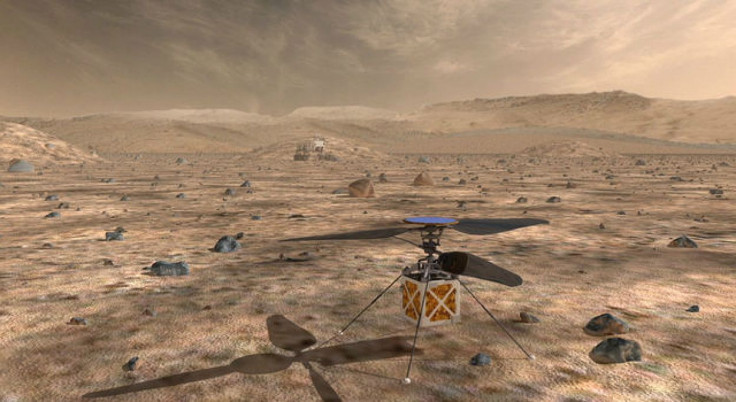NASA's Mars Helicopter: Small, Autonomous Rotorcraft To Fly On Red Planet

NASA is sending a light, autonomous rotorcraft, dubbed the Mars Helicopter, to demonstrate the viability of heavier-than-air vehicles on Mars and get a bird's eye view of the red planet.
The atmosphere of Mars is 100 times thinner than that of Earth and flying an autonomous chopper in that kind of air could prove extremely difficult. However, the agency, which has been working on this idea since 2013, has made all the necessary changes in the design of its chopper to attempt the flight.
“The altitude record for a helicopter flying here on Earth is about 40,000 feet. The atmosphere of Mars is only one percent that of Earth, so when our helicopter is on the Martian surface, it’s already at the Earth equivalent of 100,000 feet up,” Mimi Aung, Mars Helicopter project manager at JPL, said in a statement. “To make it fly at that low atmospheric density, we had to scrutinize everything, make it as light as possible while being as strong and as powerful as it can possibly be.”
That said, they have kept the fuselage of the chopper as small as a softball and its overall weight just under a couple of kilograms. For power, the vehicle packs two counter-rotating blades that will whirl 3,000 times a minute — 10 times the rate of a standard Earth-based helicopter — and enable a seamless flight. NASA has also equipped the helicopter with solar cells for charging itself with sunlight and an inbuilt-heating mechanism to keep its instruments up and running on cold Martian nights.
But before any of that happens, the rover has to be sent to and deployed on the red planet. The space agency plans to do it as part of its next Mars mission. Essentially, the chopper will be attached to the belly of 2020 Mars rover, the successor of Curiosity, and flown to Mars.
Once it’s there, the rover will drive to a suitable take-off site, detach the helicopter, and drive away. As soon as the rover is out of the area, the controllers at NASA will send out commands — which will take a few minutes to reach Mars — prompting the autonomous system integrated with the chopper to perform initial tests and then take to the skies.
“We don’t have a pilot and Earth will be several light minutes away, so there is no way to joystick this mission in real time,” Aung stated while stressing on the importance of autonomy for the demonstration.
In all, the helicopter will perform five flights over a period of 30 days. With each successive flight, the duration (90 seconds max) and distance covered will be increased (up to a few hundred meters). If the program works as NASA expects, the agency would have a whole new way to explore the Martian surface.
“Though the agency already has an orbiter lurking in space, it is way high up. The new Mars Helicopter will serve as a low-flying scout and could pave a way for similar missions that might provide access to hard-to-reach regions on Martian surface. The ability to see clearly what lies beyond the next hill is crucial for future explorers,” Thomas Zurbuchen, associate administrator for NASA's Science Mission Directorate, said in the statement. “We already have great views of Mars from the surface as well as from orbit. With the added dimension of a bird’s-eye view from a ‘marscopter,’ we can only imagine what future missions will achieve.”
That said, it is also worth noting that NASA has said if the flight demonstration is not successful, there won’t be any effect on how the next Mars rover goes about its job.
© Copyright IBTimes 2024. All rights reserved.





















